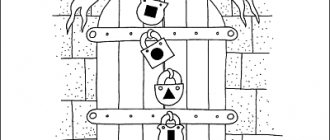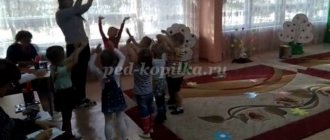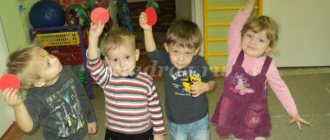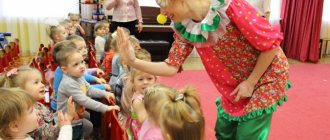Summary of a lesson in the first junior group on the topic “Construction from cubes”
Summary of educational activities in the first junior group “Tower for a cockerel”
Compiled by: Yanchenko Elena Anatolyevna, teacher of MBDOU “Kindergarten No. 11”, Seversk, Tomsk region. Goal: to form children’s ideas about cubes as parts of a construction set. Objectives: • develop productive (constructive) activities of children; • involve in the design of towers based on the model together with adults; • to form children’s ideas about the options for arranging parts on a plane (placing a cube on a cube); • develop manual skills and thinking; • develop children's active speech and ability to answer simple questions. Vocabulary: cube, tower, high, cockerel. Material: sample, 3 cubes for each child, cockerel - soft toy;
cockerel - a toy for playing with (according to the number of children). Progress of organized educational activities
1. Organizational moment The teacher brings a cockerel toy into the group. Educator: guys, look who came to us? (Children's answers.)
- That's right, it's a cockerel.
Say hello to the cockerel (Children say hello.)
Look how beautiful the cockerel is.
On his head he has a large red comb, a beard, eyes, and a beak. The cockerel has legs, wings and a tail. Next, the teacher and the children examine the cockerel. The tell-repeat-show technique is used. Educator: the cockerel is singing a beautiful song. How does the cockerel sing? (Children's answers.)
- That's right, the cockerel sings ka-ka-re-ku.
Let's all say together: cuckoo! - Guys, show how the cockerel flaps its wings (Children imitate the movements.)
The cockerels went for a walk in the group, beautifully flapping their wings, raising their legs high.
The outdoor game “Let's walk like cockerels” is performed. Educator: our cockerels were tired, they sat down on chairs to rest. The children sit at the tables. 2. Main part. Construction Educator: guys, the cockerel likes to sit high, look far away and sing a song loudly: ku-ka-re-ku! Let's build a tower for the cockerel so that our cockerel sits high and sings a song loudly. The teacher looks at the sample with the children.
Educator: look what a high tower I have. This tower is made of cubes. The cube stands on the cube. This is the kind of tower we will build. Look how I build a tower. I take a cube and put it on the table, I take another cube and put it on top of the cube, and I put another cube on top. This is the tall tower I ended up with. How did I build the tower? (Children's answers.)
- That's right, first I put one cube, then I put another cube on it, and another cube on top.
Now take the cube that is on your table and we will build a tower. Place the cubes carefully so that the tower does not fall apart. If necessary, the teacher helps the children and shows how to place a cube on a cube. Next, the teacher, together with the cockerel, examines the resulting towers and notes how beautiful, smooth, and tall they all are. The cockerel praises the children. 3. Summary The teacher gives the children small toys to play with - cockerels, and offers to play, for example: put the cockerel on the tower, walk around the tower and see how beautiful it is, etc.
Educator: these are the beautiful towers we have! - Guys, what did we build the towers from? (Children's answers.)
- That's right, we built towers from cubes.
How did we place the dice? (Children's answers.)
- Yes, we placed cubes exactly on cubes. We have a tall tower. Well done boys. Our cockerels are happy that they can now sit high and sing the song cuckoo-re-coo loudly!
We recommend watching:
Synopsis of an educational entertaining lesson for children of the first junior group Synopsis of an integrated lesson on the formation of elementary mathematical concepts using a synopsis of the educational situation in the 1st junior group Synopsis of a lesson in the first junior group. Construction from bricks
Similar articles:
Lesson summary for an early age group. Let's play with cubes
Lesson summary “Red color”. Junior group
Lesson summary “Yellow”. First junior group
Summary of a lesson in an early age group on the poem “The Dirty Girl”
Lesson summary for an early age group. Chicken and duckling
Card index games-activities with building materials for young children
Card index
games-activities
with construction
material
for young children
Objectives of education and training:
1. Continue to introduce children to some forms (cube, brick, prism, cylinder), “objectifying” them (cylinder - column, pipe).
2. Introduce methods of construction - applying, overlaying.
3. Encourage children to play with buildings together with an adult and use story toys for games.
4. To develop the ability to use familiar forms of building materials and elements of plastic construction sets when constructing their own various buildings.
Forms of working with children:
1. Organized educational activity (game-activity)
2. Joint activity of the teacher with the children (construction of buildings together with the children for later play).
3. Independent activity (construction of buildings by children for later use in games).
Lesson 1. “Tower house made of cubes of the same size.”
Program content
· Learn to build a tower from cubes, put cube on cube.
· Develop fine motor skills.
· Learn to maintain attention
· Activate children's passive and active vocabulary (take it, make it, put up a house, put a cat on a house, meow-meow)
· Cultivate neatness (learn to put cubes in a box).
Lesson 2. “House-tower of three cubes of the same size.
Program content:
· Learn to build a tower from three cubes of the same size. Laying cube on cube.
· Develop fine motor skills. Learn to maintain attention.
· Activate children's active and passive vocabulary. (Take it, make it, put it up, house, put the dog on the house, woof-woof)
Lesson 3 “Machine”
Program content:
· Learn how to build a car by placing a cube on a brick. Introduce a brick to a new detail.
· Enrich children's sensory experience, distinguish buildings by color, shape (brick cube)
· Develop attention.
· Activate children's active and passive vocabulary (rides, bi-bi, cube, brick).
· Cultivate neatness (learn to put cubes in a box)
Lesson 4 “Bus”
Program content:
· Continue learning how to build a car. Place the cube on the plate. Introduce the new plate part.
· Enrich children's sensory experience. Distinguish the building by color, shape (plate, cube).
· Develop attention.
· Activate children's active and passive vocabulary (rides, bi-bi, cube, brick)
· Cultivate neatness (learn to put cubes in a box)
Lesson 5 “Paths made of bricks of the same color.”
Program content.
· Continue to learn how to build a path from bricks, placing brick tightly against brick.
· Develop fine motor skills.
· Focus on color (red carpet).
· Activate children's active and passive vocabulary (drip-drip, top-top, brick, path).
· Cultivate accuracy in putting cubes in a box).
Lesson 6 “Table”
Program content.
· Learn to build a table by placing a brick on a cube. Make the building sustainable.
· Enrich children's sensory experience, distinguish between two types of parts - cube, brick.
· Develop fine motor skills and sustained attention.
· Activate children's active and passive vocabulary (table, cube, brick).
· Cultivate neatness (learn to put cubes in a box).
Lesson 7 “Chair”
· Software content.
· Learn to build a chair by applying a brick
· to the cube. Make the building sustainable.
· Enrich children's sensory experience by distinguishing two types of parts - a cube, a brick.
· Develop fine motor skills and sustained attention.
· Activate children's active and passive vocabulary (chair, cube, brick).
· Cultivate neatness (learn to put cubes in a box).
· Cultivate neatness (learn to put cubes in a box).
Lesson 8 “Chair and table”.
Program content.
· Learn to build a building using a variety of materials.
· Learn to build two objects of different designs. Build a table and chair using overlay techniques and applications
· Learn to distinguish buildings.
· Enrich children’s sensory experience by distinguishing two types of parts (cube, brick)
· Develop fine motor skills and sustained attention.
· Activate children's active and passive vocabulary (Table, chair, cube, brick).
· Cultivate neatness (learn to put cubes in a box).
Lesson 9 “Brick fence”
Program content.
· Learn to place a brick vertically to the table surface
· Enrich children's sensory experience by distinguishing and understanding the word “brick.” Focus children's attention on color (red fence)
· Develop fine motor skills and sustained attention.
· Activate children's active and passive vocabulary (Mau, meow, ko-ko, brick).
· Cultivate neatness (learn to put cubes in a box).
Lesson 10 “Brick fence for a dog”
Program content.
· Learn to place a brick vertically to the table surface
· Enrich children's sensory experience by distinguishing and understanding the word “brick.” Focus children's attention on color (red fence)
· Develop fine motor skills and sustained attention.
· Activate children's active and passive vocabulary (Ay, ah, woof, woof, brick).
· Cultivate neatness (learn to put cubes in a box).
Lesson 11 “Bench for matryoshka”
Program content.
· Learn to construct complex buildings and connect two building parts. Make the floors on a stable basis, placing a brick on the corners of two supporting apart cubes.
· Develop sustained attention. Enrich children's sensory experience, distinguish details by shape and color (red, blue).
· Activate children's active and passive vocabulary (bench, tired, top-top, la-la-la).
· Cultivate neatness (learn to put cubes in a box)
Lesson 12 “Colored benches”,
Program content.
· Continue to teach how to construct complex buildings and connect two building parts. Make the floors on a stable basis, placing a brick on the corners of two supporting apart cubes.
· Develop sustained attention. Enrich children's sensory experience, distinguish details by shape and color (red, blue).
· Activate children's active and passive vocabulary (bench, tired, jumped, top-top, la-la-la).
· Cultivate neatness (learn to put cubes in a box)
Lesson 13 “House”
Program content.
· Introduce a new prism part.
· Learn to place a prism on a cube and build a building upwards.
· Develop sustained attention. Enrich children's sensory experience by distinguishing parts by shape (cube, prism, roof).
· Activate children's active and passive vocabulary (roof, house, walked, sang a song la, la, la).
· Cultivate neatness (putting cubes in a box)
Lesson 14 “Tower of two cubes
Program content.
· Continue to learn how to build a building upwards.
· Distinguish between the size of a cube: big and small.
· Activate children's active and passive vocabulary (big, small, cockerel, peek-a-boo).
· Cultivate neatness (putting cubes in a box)
Lesson 15 “Sofa”
Program content.
· Continue learning how to build furniture.
· Teach to attach a brick placed flat to a brick placed on the long narrow side.
· Develop fine motor skills and sustained attention.
· Activate children's active and passive vocabulary. (Sofa, the doll is tired, a brick, bye-bye.)
· Cultivate accuracy by teaching how to put cubes in a box.
Lesson 16 “Bed”
Program content.
· Teach to a brick laid flat, place bricks placed on the narrow side on the sides.
· Develop fine motor skills and sustained attention.
· Activate children's active and passive vocabulary. (Crib, bunny, brick, bye-bye.)
· Cultivate neatness (learn to put cubes in a box).
Lesson 17 “Sofa and table”
Program content.
· Learn to build a building using a variety of materials.
· Learn to construct two objects of different designs, combining them into one plot.
· Develop sustained attention. Enrich children's sensory experience, distinguish details by the shape of a cube or brick.
· Activate children's active and passive vocabulary (Table, sofa, cube, brick).
· Cultivate neatness (learn to put cubes in a box).
Lesson 18 “Crib and track”
Program content.
· Learn to construct two objects of different designs, combining them into one plot.
· Develop sustained attention. Enrich children's sensory experience, distinguish details by shape and color: cube, brick, red, blue.
· Activate children's active and passive vocabulary (Crib, path, top-top, cradle-bye, brick).
· Cultivate neatness (learn to put cubes in a box).
Lesson 19 “A fence made of bricks and cubes for a dog”
Program content.
· Continue to teach children to place bricks on a short, narrow edge, while alternating building parts according to shape.
· Enrich children's sensory experience, distinguish between the details of a cube, a brick.
· Focus on the color red-green fence)
· Activate children's active and passive vocabulary (Ay-Ay, Woof-woof).
· Cultivate neatness (learn to put cubes in a box)
Lesson 20 “Gates”
Program content.
· Continue to learn how to make the simplest ceilings, connecting two parts with a third.
· Develop fine motor skills, coordination of both hands, sustained attention.
· Activate active and passive vocabulary for children (gate, tired, flew, sat down, pee-pee-pee).
· Cultivate neatness (learn to put cubes in a box).
Lesson 21 “Gates and fence”
Program content.
· Learn how to build a building for the game.
· Consolidate acquired skills in building fences and gates.
· Develop fine motor skills. Coordination of both hands, steady attention.
· Activate active and passive, children's vocabulary (gate, fence, brick).
· Cultivate neatness (learn to put cubes in a box).
Lesson 22 “Colored benches and paths”,
Program content.
· Learn to combine buildings into a plot.
· Strengthen the ability to construct complex buildings and connect two building parts. Make the floors on a stable basis, placing a brick on the corners of two supporting apart cubes.
· Develop sustained attention. Enrich children's sensory experience, distinguish details by shape and color (red, blue).
· Activate children's active and passive vocabulary (bench, tired, path).
· Cultivate neatness (learn to put cubes in a box)
Lesson 23 “House and car”
Program content.
· Learn how to build a building for the game.
· Consolidate acquired skills in building a house or car.
· Develop fine motor skills. Coordination of both hands, steady attention.
· Activate children's active and passive vocabulary (house, car, cube, brick).
· Cultivate neatness (learn to put cubes in a box).
Lesson 24 “Gate, path and house”
Program content.
· Learn how to build a building for the game.
· Reinforce acquired construction skills.
· Develop fine motor skills. Coordination of both hands, steady attention.
· Activate children's active and passive vocabulary (house, gate, path, cube, brick, prism, roof).
· Cultivate neatness (learn to put cubes in a box).
Lesson: 25 “Houses for nesting dolls”
Program content.
· Development of basic constructive skills in the process of working with building parts.
· Learn to build floors.
· Develop color perception.
· Develop a desire for playful and verbal communication.
· Learn to disassemble buildings, put parts in a box, put away toys. (see lesson notes)
Lesson 26 “According to children’s plans”
Program content.
· Reinforce acquired construction skills.
· Develop fine motor skills. Coordination of both hands, steady attention.
· Activate children's active and passive vocabulary
· Cultivate neatness (learn to put cubes in a box).






